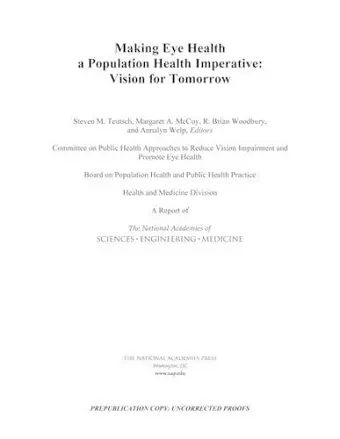Making Eye Health a Population Health Imperative
Vision for Tomorrow
Board on Population Health and Public Health Practice author National Academies of Sciences, Engineering, and Medicine author Health and Medicine Division author Committee on Public Health Approaches to Reduce Vision Impairment and Promote Eye Health author Margaret A McCoy editor Steven M Teutsch editor Annalyn Welp editor R Brian Woodbury editor
Format:Paperback
Publisher:National Academies Press
Published:15th Jan '17
Currently unavailable, and unfortunately no date known when it will be back

The ability to see deeply affects how human beings perceive and interpret the world around them. For most people, eyesight is part of everyday communication, social activities, educational and professional pursuits, the care of others, and the maintenance of personal health, independence, and mobility. Functioning eyes and vision system can reduce an adult's risk of chronic health conditions, death, falls and injuries, social isolation, depression, and other psychological problems. In children, properly maintained eye and vision health contributes to a child's social development, academic achievement, and better health across the lifespan.
The public generally recognizes its reliance on sight and fears its loss, but emphasis on eye and vision health, in general, has not been integrated into daily life to the same extent as other health promotion activities, such as teeth brushing; hand washing; physical and mental exercise; and various injury prevention behaviors. A larger population health approach is needed to engage a wide range of stakeholders in coordinated efforts that can sustain the scope of behavior change. The shaping of socioeconomic environments can eventually lead to new social norms that promote eye and vision health.
Making Eye Health a Population Health Imperative: Vision for Tomorrow proposes a new population-centered framework to guide action and coordination among various, and sometimes competing, stakeholders in pursuit of improved eye and vision health and health equity in the United States. Building on the momentum of previous public health efforts, this report also introduces a model for action that highlights different levels of prevention activities across a range of stakeholders and provides specific examples of how population health strategies can be translated into cohesive areas for action at federal, state, and local levels.
Table of Contents- Front Matter
- Summary
- 1 Introduction
- 2 Understanding the Epidemiology of Vision Loss and Impairment in the United States
- 3 The Impact of Vision Loss
- 4 Surveillance and Research
- 5 The Role of Public Health and Partnerships to Promote Eye and Vision Health in Communities
- 6 Access to Clinical Vision Services: Workforce and Coverage
- 7 Toward a High-Quality Clinical Eye and Vision Service Delivery System
- 8 Meeting the Challenge of Vision Loss in the United States: Improving Diagnosis, Rehabilitation, and Accessibility
- 9 Eye and Vision Health: Recommendations and a Path to Action
- Appendix A: Committee Biographies
- Appendix B: Committee Meeting Agendas
- Appendix C: Glossary
- Appendix D: Examples of Federal...
ISBN: 9780309439985
Dimensions: unknown
Weight: unknown
586 pages